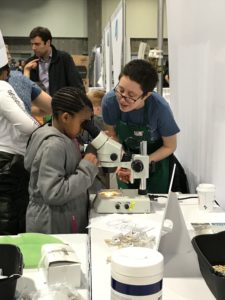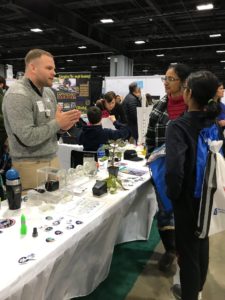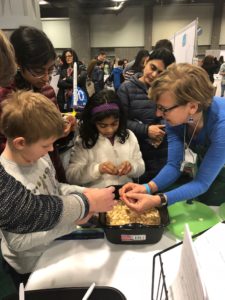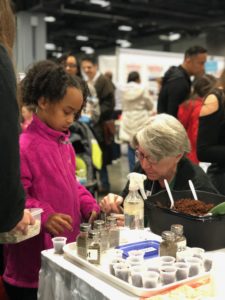
ASPB’s Education and Outreach Committee hosted an outreach booth at the 5th USA Science & Engineering Festival (USASEF) in Washington, DC on April 6-8, 2018. Held at the Walter E. Washington Convention Center, the event brought in over 370,000 visitors and occupied 2.3 million square feet of convention space. The Festival drew a large, diverse audience of all ages, ethnicities and backgrounds, from professionals to novices, from science enthusiasts to the merely curious.
Drawing on the Festival’s 2018 theme of “STEM Can Take You,” activities at the ASPB booth took visitors on a journey of the places plants can take you- including space, into a carnivorous plant, and outdoors in the garden. Visitors took home over 2,500 garden cup necklaces containing radish, carrot, lettuce, or sunflowers, learning about the conditions seeds require to grow. One 2016 USASEF booth visitor returned to the ASPB booth to share that he successfully grew (and consumed) the lettuce he planted two years ago! Visitors also dissected lima beans to discover the “baby plant” inside and learned how to use a microscope to investigate further. Other activities and takeaways included the 12 Principles of Plant Biology bookmarks and accompanying labs, the ever popular My Life as a Plant coloring book, and Plant Cell and Plant Physiology posters.

At the far end of the ASPB booth, Expo attendees learned about plant gravitropism and space flight experiments. Through visual aids and live-plant demos, ASPB volunteers explained the biology and importance of gravity sensing in plants. A coleus plant turned on its side showed onlookers a gravitropic response in real time, while Arabidopsis seedlings spun on a clinostat to demonstrate a microgravity simulation. Volunteers went on to explain how and why plant biologists send plants to space. Attendees of all ages enjoyed learning about the plant experiments aboard the International Space Station and the future of space biology.

Mark Eastburn, an ASPB BLOOME Grant 2016 recipient, connected brain science with plant science at the ASPB booth by showing visitors how they could measure the action potentials of Venus flytraps with equipment purchased through his grant. Over the past two years, Mark has been working with students in grades K-12 and researchers from the Princeton Neuroscience Institute to investigate the response of Venus flytraps to various stimuli, and opening minds to the possibilities that plants may do things that we thought only brains could do, like count and remember. Carnivorous plants have been a great way to integrate the 12 Principles of Plant Biology into a wide range of lessons, from respiration and energy to biodiversity, evolution, and biological processes. More information on these lessons will soon be available at http://www.plantsandstudents.com.
USASEF’s recap report shares that over 2,000 schools participated in the Festival. Media coverage leading up to, during, and following the event resulted in 11.59 million + impressions. With such a wide reach, ASPB’s role in helping students and the broader community understand why plants matter is more critical than ever.

We would like to offer a special thanks to our volunteers for helping to make our booth a success: Sarah Wyatt (University of Ohio), Al Meyer (University of Ohio), Ava Heller (University of Ohio), Pal Maliga (Rutgers), Alenka Hlousek-Radojcic (University of Delaware), Mark Eastburn (Princeton schools), Rachel Dweikat (Georgetown University), Susan Lawrence (USDA), Janet Slovin (USDA), Malcolm Slovin, Susan Gachara (University of Delaware), Kristen Bishop, Tyrone Spady (ASPB), Crispin Taylor (ASPB), Natalie Henkhaus (ASPB), Stephanie Liu (ASPB), and Justin Liu.
